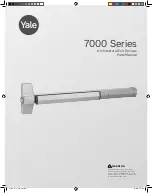
SAFETY INSTRUCTIONS AND WARNINGS
TWEC0 201TS
Manual 0-5150 1-5
Safety Instructions and Warnings
D. Personal Protection
Gas flames produce infrared radiation which may have a harm ful
effect on the skin and especially on the eyes. Select goggles or a
mask with tempered lenses, shaded 4 or darker, to protect your eyes
from injury and provide good visibility of the work.
Always wear protective gloves and flame-resistant clothing to protect
skin and clothing from sparks and slag. Keep collars, sleeves, and
pockets buttoned.
DO NOT
roll up sleeves or cuff pants.
When working in a non-welding or cutting environment, always wear
suitable eye protection or face shield.
!
WARNING
Practice the following safety and operation precautions
EVERY TIME you use pressure regulation equipment.
Deviation from the following safety and operation
instructions can result in fire, explosion, damage to
equipment, or injury to the operator.
E. Compressed Gas Cylinders
The Department of Transportation (DOT) approves the design and
manufacture of cylinders that contain gases used for welding or
cutting operations.
1. Place the cylinder (Figure 1-1) where you will use it. Keep
the cylinder in a vertical position. Secure it to a cart, wall, work
bench, post, etc.
Art # A-12127
Figure 1-1: Gas Cylinders
!
WARNING
Cylinders are highly pressurized. Handle with care.
Serious accidents can result from improper handling
or mis use of compressed gas cylinders DO NOT drop
the cylinder, knock it over, or expose it to excessive
heat, flames or sparks. DO NOT strike it against other
cylinders. Contact your gas supplier or refer to CGA
P-1 “Safe Handling of Compressed Gases in Contain-
ers” publication.
NOTE
CGA P-1 publication is available by writing the Com-
pressed Gas Association, 4221 Walney Road, 5th
Floor, Chantilly,VA 20151-2923
2. Place the valve protection cap on the cylinder whenever
mov ing it, placing it in storage, or not using it. Never drag
or roll cylinders in any way. Use a suitable hand truck to
move cylin ders.
3. Store empty cylinders away from full cylinders. Mark them
“EMPTY” and close the cylinder valve.
4. NEVER use compressed gas cylinders without a pressure
reducing regulator attached to the cylinder valve.
5. Inspect the cylinder valve for oil, grease, and damaged
parts.
!
WARNING
DO NOT use the cylinder if you find oil, grease or dam-
aged parts. Inform your gas supplier of this condition
immediately.
6. Momentarily open and close (called “cracking”) the cylinder
valve to dislodge any dust or dirt that may be present in the
valve.
CAUTION
When cracking the cylinder valve, DO NOT stand
directly in front of the cylinder valve. Always perform
cracking in a well ventilated area. If an acetylene cyl-
inder sprays a mist when cracked, let it stand for 15
minutes. Then, try to crack the cylinder valve again.
If this problem persists, contact your gas supplier.
Summary of Contents for ArcMaster 201 TS
Page 6: ...TABLE OF CONTENTS This Page Intentionally Blank...
Page 18: ...TWECO 201TS INTRODUCTION introduction 2 2 Manual 0 5150 This Page Intentionally Blank...
Page 48: ...TWECO 201TS TROUBLESHOOTING Troubleshooting 6 12 Manual 0 5150 Art A 09895_AB...
Page 50: ...TWECO 201TS TROUBLESHOOTING Troubleshooting 6 14 Manual 0 5150 This Page Intentionally Blank...
Page 61: ...DISASSEMBLY PROCEDURE TWECO 201TS Manual 0 5150 7 11 Disassembly Procedure 6 2 Art A 10179...
Page 71: ...Manual 0 5150 8 9 Assembly Procedures ASSEMBLY PROCEDURE TWECO 201TS 1 Art A 10160...
Page 78: ...TWECO 201TS ACCESSORIES Accessories 10 2 Manual 0 5150 This Page Intentionally Blank...












































